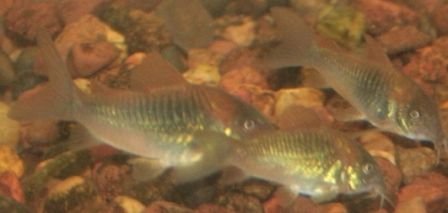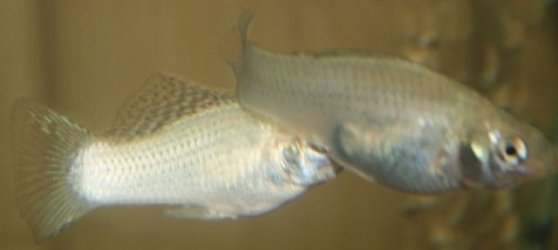2 of my Molly's have red poo. The scales are not as shiny as they were but the fish act normal. The male had a very small bump on it's side, it looked like it was under just one scale. The male also has 3 small like strips on it's side where the scales are not shiny like those around the area. I don't see any signs of external parasites. My Cory's I thought I bought emerald but, I think they are bronze. The sides of the Cory's are shiny like emerald but, on the head and down the top it looks bronze or rust colored. I will try to get some pictures.
I recently noticed 2 babies. Can I treat for parasites with the fry still in the tank? I am not too concerned about the fry. I know there will always be more with livebearers. Also, I am close to the limit on fish for my tank (considering the adult size of all fish and the expectation of new fry) and I am looking at changing to a larger tank soon.
I have a parasite treatment with sodium chloride, nitrofurazone, triethylene gycol, acriflavine, potassium dichromate.
Another treatment says it is for flukes and external parasites and contains potassium permangaate.
20G (75L) tank,
2 external filters 360GPH (1360 Lph) flow,
2 air stones
1 150W heater, 80F (27C)
6 fake plants
1/4" gravel 1/2" - 3/4" depth
setup for about 2 months with fish
7.4 ph
150 ppm alkalinity
120 ppm total hardness
0 ppm nitrites
0 ppm ammonia
10 ppm nitrates
25% wc weekly
3 bronze cory's, 1 added 3 weeks ago
1 male sailfin molly
2 female silver sailfin molly, 1 added 3 weeks ago
1 female silver balloon molly, added 3 weeks ago
2 newborn fry, just noticed 2 days ago
I recently noticed 2 babies. Can I treat for parasites with the fry still in the tank? I am not too concerned about the fry. I know there will always be more with livebearers. Also, I am close to the limit on fish for my tank (considering the adult size of all fish and the expectation of new fry) and I am looking at changing to a larger tank soon.
I have a parasite treatment with sodium chloride, nitrofurazone, triethylene gycol, acriflavine, potassium dichromate.
Another treatment says it is for flukes and external parasites and contains potassium permangaate.
20G (75L) tank,
2 external filters 360GPH (1360 Lph) flow,
2 air stones
1 150W heater, 80F (27C)
6 fake plants
1/4" gravel 1/2" - 3/4" depth
setup for about 2 months with fish
7.4 ph
150 ppm alkalinity
120 ppm total hardness
0 ppm nitrites
0 ppm ammonia
10 ppm nitrates
25% wc weekly
3 bronze cory's, 1 added 3 weeks ago
1 male sailfin molly
2 female silver sailfin molly, 1 added 3 weeks ago
1 female silver balloon molly, added 3 weeks ago
2 newborn fry, just noticed 2 days ago



 /www.thegreenmachineonline.com/products/aquatics/fish-food-medication/medication/sera-nematol-50ml
/www.thegreenmachineonline.com/products/aquatics/fish-food-medication/medication/sera-nematol-50ml

